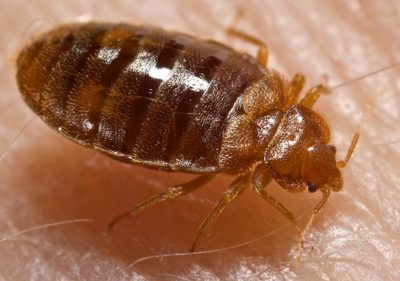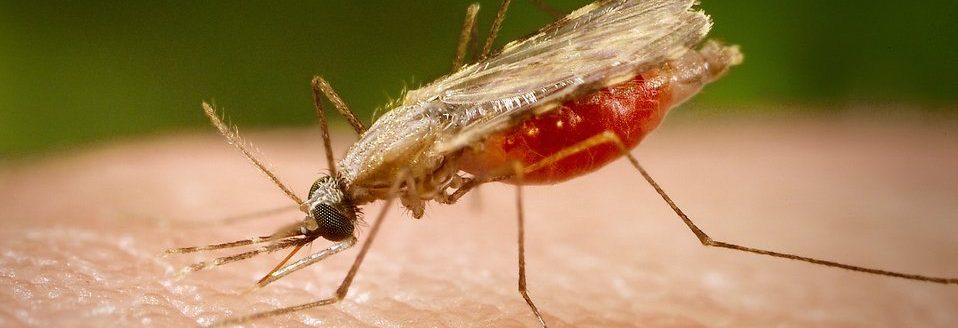Bed Bugs: Everything You Need to Know
Bed bugs are a living nightmare. Within a short period of time, bed bugs can infest your sleeping area and bite you frequently during the night. Although bed bug bites don’t transmit diseases, they can cause allergic reactions. Stopping a bed bug infestation early is crucial to prevent the bed bugs from spreading to other areas of the home.
If you suspect a bed bug infestation, follow these steps:
- Confirm presence of bed bugs by looking for the bugs, bloodstains or fecal matter on mattresses or bedding.
- Inspect mattress seams, luggage, backpacks and other items bed bugs may have traveled in.
- Check other areas of the home to determine if the infestation has spread.
- Launder all clothing and bedding materials with hot water.
- Call a pest control company for assistance with removing bed bugs from the home.
Bed bugs are notoriously hard to eradicate without professional assistance. Bed bugs can easily hide in the smallest of cracks and crevices to avoid detection. Even if you believe bed bugs are gone from the home, they may easily come back if you aren’t aggressive enough from the start.
What Are Bed bugs?
 Bed bugs are parasites that have been around just as long as humans. To survive, they are dependent on human blood. This is the reason bed bugs prefer to make their homes close to humans in mattresses, box springs, couches, and upholstered chairs. However, bed bugs can reside in any type of furniture including dressers, nightstands and desks.
Bed bugs are parasites that have been around just as long as humans. To survive, they are dependent on human blood. This is the reason bed bugs prefer to make their homes close to humans in mattresses, box springs, couches, and upholstered chairs. However, bed bugs can reside in any type of furniture including dressers, nightstands and desks.
The appearance of bed bugs is dependent on whether or not they have recently fed. They are typically brown with an oval shape and may only be the size of an apple seed — very similar in appearance to carpet beetles and often mistaken for the critters. After a feeding, their bodies become engorged and their shells get a reddish tint. They will typically measure no more than ¼.” Bed bugs have wings, although they don’t have the ability to fly. Additional characteristics of bed bugs include pronounced beaks and antennae sectioned in four parts.
Although bed bugs don’t fly, they can move rapidly over surfaces. They also have the ability to move from floors to walls to ceilings. Bed bugs reproduce at startling rates with each female having the ability to lay hundreds of eggs. Bed bug eggs are hard to detect since each one is no larger than a speck of dust.
Young bed bugs, called nymphs, are smaller than full-grown adults and have a translucent color. Until they feed, they retain this color. Nymphs typically take one to three months to fully mature and require multiple feedings to shed their skin for each stage of development. Nymph shells usually have a yellowish tint.
Bed Bug Early Detection
Detecting bed bugs early will help you get rid of the pests before serious complications arise. Treating a widespread bed bug infestation is costly and may take several weeks to months to fully eradicate the pests from your home.
There are several reasons a homeowner may suspect a bed bug infestation. You may have seen a live bug or physical signs of their existence. Or you or a family member has developed symptoms you suspect could be caused by bed bug bites. Symptoms of bed bug bites may include:
- Red and swollen marks on the skin with a dark red center
- Markings are grouped together in a small area on the skin
- Itching or burning sensation at bite site
- Bites appear on areas of the skin exposed during sleep
If you do have bed bug bites, it’s important not to scratch the area. Scratching the skin increases the risk of infection or scarring. In some cases, bed bug bites do not cause a rash and individuals will not demonstrate any symptoms. When no skin reaction is present, the bed bugs may go unnoticed for quite some time.
However, bite marks on the body from bed bug feedings are not always a good indicator since a number of pests are known to bite, including mosquitoes. The bite marks may also look the same as common rashes like eczema. To confirm the presence of bed bugs, you should instead look for physical signs of the pests.
How Do You Check for Bed bugs?
Bed bugs are not always easy to identify and when you are searching common areas for bed bug sightings, you may not always come across the live pests. However, bed bugs will leave behind evidence of their presence in the home.
Here are the most common physical signs left by bed bugs on mattresses and linens:
- Live adult bed bugs and nymphs.
- Red stains: Rust-colored markings on the mattress are caused by bed bugs being crushed by the weight of those sleeping on the bed.
- Dark circular spots: Very small black dots on any bedding could indicate bed bug excrement.
- Yellow casings: As young bed bugs reach adulthood, they shed their yellow exoskeletons, which are approximately 1 mm.
- Translucent clusters: Bed bugs lay milky-white eggs with a grain-like shape. Females lay between one and five eggs daily with a total of 500 eggs in their lifetimes.
The first spot to check for bed bugs is your mattress. Remove bedding completely and inspect the mattress thoroughly. Take a close look at any seams or piping. They can also sneak into cracks and crevices found on the headboard and footboard. Bed bugs can also be located within the box spring. Check bedding regularly for bed bugs while you are cleaning. Retailers also sell detection devices for bed bugs. A trap is placed under your mattress and is designed to capture bed bugs inside. Check the trap regularly to determine if any bed bugs are lurking in your bed.
Within a room that is heavily infested, you may also find bed bugs in the following areas:
- Cushions and cushion seams
- Drawer and nightstand joints
- Baseboard cracks
- Wall hangings
- Wallpaper
- Draperies
- Floor, window and door frames/molding
- Electrical outlets
- Mattresses
- Box springs
- Bed frames
- Headboards
- Footboards
- Chairs
- Couches
- Carpets
When searching for bed bugs, check common hiding spots within the bedrooms of your residence. Bed bugs can infest other areas of the home, but bedrooms are the most common sites. As you canvass each area, use a flashlight for improved visibility. Use a scraper or ruler to push aside seams and folds to investigate areas where bed bugs could hide undetected.
For any furniture, pay close attention to the seams and tags since bed bugs may cluster in these spots. Bed bugs are very thin and elongated—approximately 1 mm wide and 8 mm long. Since they only measure about the width of a credit card, they are able to get into the smallest of crevices. In the majority of cases, bed bugs will reside in a warm, dark spot within five to seven feet of where humans sleep. However, bed bugs have been known to travel up to 20 feet to feed on their hosts. Bed bugs primarily feed on human blood at night and stay hidden during daylight hours. Feedings are required every 14 days for bed bugs to survive. If bed bugs are ravenous, they will attempt to feed during the day.
Bed Bugs at Hotels
Bed bugs are a well-known problem at hotels. According to a recent survey from the Pest Control Management Association, hotels and motels are the third most popular spot for bed bug infestations. With the high turnover rate of guests, bed bugs can easily be transported into guestrooms. Bed bugs are also resilient and can withstand the elements as you travel from place to place, making it easy for guests to unintentionally bring bed bugs from hotels to their personal homes. Bed bugs can infest your home if they get into your clothing or luggage during your vacation stay.
How Do You Prevent Bed bugs During Travel?
Before you unpack in your hotel room, take the following steps if you want to avoid bed bug exposure:
- Keep suitcases away from the bed or any furniture. Place the suitcase on luggage rack or in the hotel bathroom while you investigate the room.
- Look for physical signs of bed bugs on all linens, the mattress, and the box spring. Also, do a thorough inspection of any headboards, baseboards and cushions. Check for blood, excrement, eggs, and live bugs.
- Search the furniture for any bed bugs. Pay close attention to upholstered furniture pieces. Lift up cushions and check all couch pillows too. A flashlight and magnifying glass could be useful as you search all areas.
- Alert staff and request a new room if you suspect bed bugs. Since bed bugs can travel, don’t relocate to an adjacent room.
- Store luggage in a large plastic bag during the hotel stay. Seal the bag when not in use to keep out any roaming bugs.
If you don’t suspect bed bugs at your hotel, you should still stay vigilant and take precautions to help ensure you didn’t miss the signs and that you don’t inadvertently take bed bugs home with you.
- Inspect luggage and clothing while packing your suitcases. Look again closely when you get home and unpack.
- Keep luggage away from sleeping areas. Choose an alternate area to unpack after a trip.
- Wash and dry all unpacked clothing items at a high temperature before putting them away in closets and drawers. Bed bugs can’t survive in temperatures above 120 degrees Fahrenheit.
Keep in mind that if you need to change rooms at a hotel don’t allow the establishment to move you to a room next door. If a bed bug infestation was to spread, it could affect neighboring rooms. Repeat inspection of the room after you are moved. If you still see signs of bed bugs, your best bet is to ask for a refund and find another hotel.
For more information preventing bed bugs while traveling, see: A Traveler’s Guide to Bed Bug Prevention.
Are Bed bugs Harmful to Humans?
They can be. Bed bugs don’t carry diseases that can be transmitted to humans through their bites, but they can cause allergic skin reactions that result in hives. Secondary infection can occur as a result of scratching bed bug bites. Skin reactions from bites may take several days to appear. In rare cases, bed bug bites trigger a severe allergic reaction that requires emergency medical care. Exposed body parts such as the arms, neck, face and hands are most often where bed bug bites will appear. Antihistamines and antiseptic lotions can help relieve some of the discomfort caused by bed bug bites.
Bed bugs can also become a nuisance since they can interrupt sleep. Individuals may feel lethargic if they are residing in a bedroom that’s infested with bed bugs.
How Do You Get Rid of Bed bugs?
A bed bug infestation is very difficult to manage without professional assistance. Store bought sprays and traps aren’t reliable. Once an infestation takes over a room, the bed bugs can start to spread to other areas. It’s very important to notify landlords of the infestation if you reside in an apartment building. The landlord will contact other apartment dwellers and make arrangements with a pest control agency. For homeowners, your first step after identifying the presence of bed bugs is to contact a pest control company.
To prepare for treatment, any items within the infested room should be placed in sealed trash bags. This may include clothing items, bedding materials and draperies. If you have carpet in the room, vacuum the area methodically. Empty the vacuum outdoors after use.
A pest control company will come out to your home and do a comprehensive inspection. The company will make recommendations based on the extent of the infestation. For instance, if a piece of furniture can’t be salvaged, it should be removed from the home immediately. Once discarded, the furniture should be rendered unusable to avoid the spread of the bed bugs. For instance, mattresses are often spray painted red after a bed bug infestation.
Treatment methods performed by a pest control company will vary. Companies may use a portable heating device that raises the room temperature to a point that bed bugs aren’t able to survive. Treatment time may last upwards of four hours and require that pets and humans leave the premises. Any heat-sensitive belongings need to also be removed.
Using insecticides is another approach, one which we prefer. As with our other pest control treatments, the chemicals used are chosen to maximize both environmental friendliness and effectiveness in ridding you of the pests. We use our expertise to find the best and safest solution to your problem.
Having bed bugs shouldn’t be an embarrassment and doesn’t reflect on your home’s cleanliness. Bed bugs can easily find their way into any type of home at any given time. Get in touch with Carolina Pest Management immediately if you reside in the Charlotte area and suspect bed bugs are inside your home. Infestations can spread quickly and our goal is to offer safe and effective treatment options to eradicate the bed bug problem completely. Our trained technicians will remove the bed bugs from your home within hours. With treatment, furniture items can usually be salvaged. Contact us today for bed bug control services in the Charlotte area.


